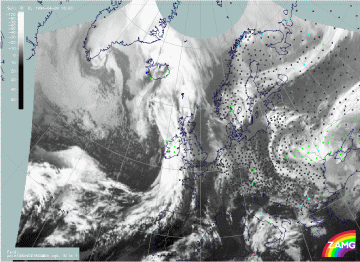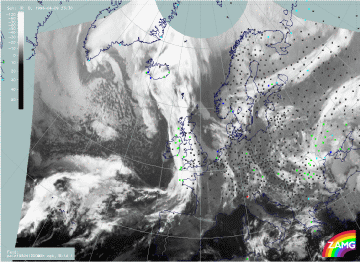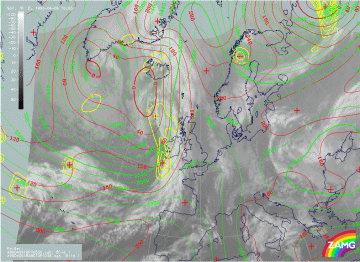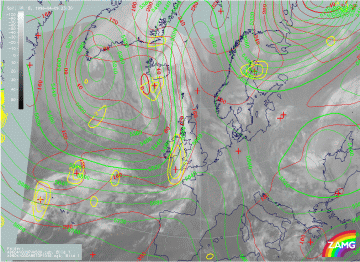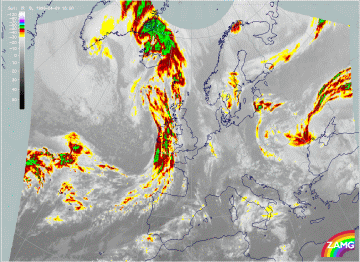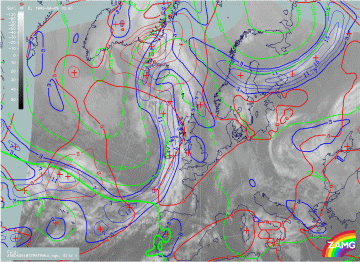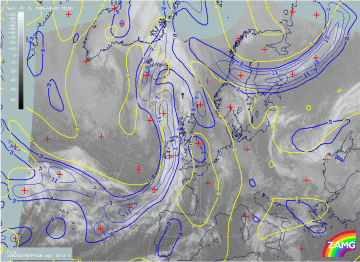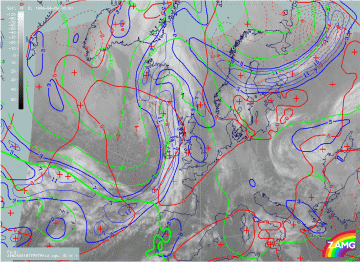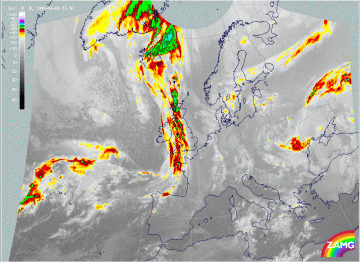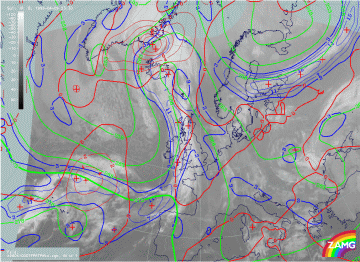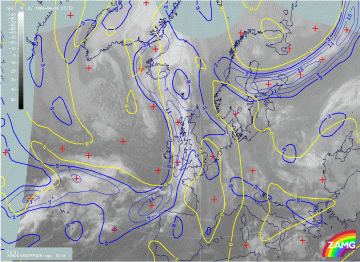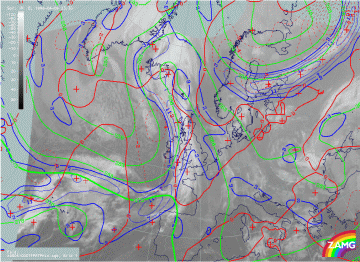09 - 10 April 1996 - Forecast For Cold Front
|
09 April 1996/18.00 UTC - Meteosat IR image; weather events (green: rain and showers, blue: drizzle, cyan: snow, purple: freezing rain,
red: thunderstorm with precipitation, orange: hail, black: no actual precipitation or thunderstorm with precipitation)
|
10 April 1996/00.00 UTC - Meteosat IR image; weather events (green: rain and showers, blue: drizzle, cyan: snow, purple: freezing rain,
red: thunderstorm with precipitation, orange: hail, black: no actual precipitation or thunderstorm with precipitation)
|
The satellite image at 18.00 UTC (left image) shows the cloud band of the Cold Front extending from the Canary Islands across Ireland to the Atlantic south-west of Iceland at approximately 60N/17W. The Cold Front is accompanied by a mesoscale substructure in the form of a Wave which can be found above and south of Ireland. The area of the wave is also accompanied within the satellite image by the coldest cloud tops (compare Forecast for Wave ). Although the frontal cloudiness is mostly situated above the Atlantic, the synoptic stations within the system (Ireland) report rain and showers (green crosses).
At 00.00 UTC the Cold Front can be found in the satellite image (right image) extending from the Atlantic north-west of the Iberian Peninsula, over the British Isles to Iceland. The Wave is situated above Ireland (compare Forecast for Wave ). As at 18.00 UTC, major parts of the frontal cloudiness are situated above the Atlantic. The synoptic stations situated within the cloud band report drizzle (blue crosses), rain and showers (green crosses).
|
09 April 1996/18.00 UTC - Meteosat IR image; red: height contours 1000 hPa, green: height contours 500 hPa, yellow: positive vorticity
advection (PVA) 500 hPa
|
10 April 1996/00.00 UTC - Meteosat IR image; red: height contours 1000 hPa, green: height contours 500 hPa, yellow: positive vorticity
advection (PVA) 500 hPa
|
The left image above includes the absolute topography height contours at 1000 and 500 hPa at 18.00 UTC. The absolute topography at 1000 hPa contains a pronounced surface low stretching from the Atlantic at approximately 58N/18W to south-west Iceland. This configuration or form of surface low is typical for two weaker surface low centres. While the northern core of the low belongs to the frontal system situated north and east of Iceland, the southern one belongs to the described Cold Front. At both heights a well-developed trough can be observed at the rearside of the frontal cloud band at the downstream side of the Wave. This configuration of the absolute topography is typical for a still developing frontal system. The part of the Cold Front situated rear upstream of the Wave is, like the downstream part, also characterized by a trough at both heights. But in contrast to the situation north of the Wave this trough is much weaker, especially within the absolute topography at ground level (1000 hPa). This is the consequence of the frontal system approaching from the rear situated above the Atlantic north to north-west (compare also the fourth part of this case study "Special Investigation": Rapid Cyclogenesis).
The third parameter which is superimposed on the image is the field of PVA at 500 hPa greater than 2 units. At 18.00 UTC (left image above) the northern part of the Cold Front and the area of the Wave is characterized by pronounced values of PVA. The field of PVA contains two maxima - a weaker maximum at the rear Cold Frontal cloud edge at approximately 58N/15W and a strong maximum within the area of the Wave which will be described in more detail within the sub-chapter Forecast for Wave . These pronounced values of PVA are a characteristic indication of an approaching or a deepening trough.
The right image above includes the absolute topography height contours at 1000 and 500 hPa at 00.00 UTC. At both heights a pronounced trough can be observed behind the Cold Front. Compared with the left image (18.00 UTC), a deepening of the trough within the last six hours can be observed. This deepening was already indicated by the pronounced values of PVA at 18.00 UTC (see also the paragraph above).
|
09 April 1996/18.00 UTC - Meteosat IR enhanced image
|
09 April 1996/18.00 UTC - Meteosat IR image; blue: thermal front parameter (TFP) 500/850 hPa, green: equivalent thickness 500/850 hPa,
red: temperature advection - WA 1000 hPa
|
|
09 April 1996/18.00 UTC - Meteosat IR image; blue: thermal front parameter (TFP) 500/850 hPa, yellow: shear vorticity 300 hPa
|
|
The satellite image (left image top) shows, especially within the northern part of the Cold Front (north of Wave), cold (high) cloud tops within the whole area of the Cold Front cloudiness. This is a very typical configuration for a so-called iI>Ana Cold Front. For an exact analysis of the Ana Cold Front the distribuion of the key parameters has to be investigated, which will be done within the next paragraph.
Looking at the thermal conditions at 18 UTC (right image top), the crowding zone of equivalent thickness can be found within the frontal cloud band of the Cold Front. As a consequence of the position of the crowding zone, the maximum values of the TFP can be found within the leading part of the frontal cloudiness. The third superimposed parameter is the field of temperature advection (warm advection). Typical for an Ana Cold Front, the frontal cloud band is within cold advection. The zero line of temperature advection can be found along the leading cloud edge. Another key parameter combination constitutes the next image (left image bottom): the TFP and the zero line of shear vorticity at 300 hPa. Like the parameter combination described above, this image confirms the fact that the Cold Front is of the Ana Cold Front type. In the case of an Ana Cold Front the zero line of the shear vorticity at 300 hPa (indicating the jet axis) is parallel to the rear edge of the frontal cloud band. The meteorological background of this distribution is that at higher levels on the cyclonic side of the jet the dry relative stream of the dry intrusion is parallel to the rear frontal cloud band. The result of this process is that only moist air is transported through the Cold Front cloudiness on the anticyclonic side of the jet. Therefore no cloud dissolution will take place, which leads to the typical split front character within the image of a Kata Cold Front (for more information compare also Conceptual Models: Cold Front and Conceptual Models: Split Front ).
|
09 April 1996/18.00 UTC - Meteosat IR image; blue: thermal front parameter (TFP) 500/850 hPa, green: equivalent thickness 500/850 hPa,
red: temperature advection - CA 1000 hPa
|
|
In contrast to the northern part of the Cold Front (north of the Wave), the southern part (south of the Wave) is mostly characterized by warmer (low) cloud tops (left image top). The reason for the mostly deeper cloudiness is that this part of the Cold Front is mainly of the type connected with cold advection. As described within the first part of this case study, further development depends on the distribution of the cold advection. In the case of this Cold Front it can be observed that there is no pronounced temperature contrast between the air situated in front of, and that behind, the Cold Front. The reason for the weak temperature gradient within this area is caused by the eastward moving frontal system situated immediately behind (see also the fourth part of this case study "Special Investigation": Rapid Cyclogenesis). Due to this missing temperature contrast no further development or frontogenesis can be expected (for information compare also Conceptual Models: Cold Front in Cold Advection ).
|
10 April 1996/00.00 UTC - Meteosat IR enhanced image
|
10 April 1996/00.00 UTC - Meteosat IR image; blue: thermal front parameter (TFP) 500/850 hPa, green: equivalent thickness 500/850 hPa,
red: temperature advection - WA 1000 hPa
|
|
10 April 1996/00.00 UTC - Meteosat IR image; blue: thermal front parameter (TFP) 500/850 hPa, yellow: shear vorticity 300 hPa
|
|
The satellite image (left image top) shows like the image from 18.00 UTC, cold (high) cloud tops within the area of the Wave (see sub-chapter Forecast for Wave ) and within the northern part (north of the Wave) of the cloud band of the Cold Front (Ana Cold Front). The southern part of the Cold Front (south of the Wave) is characterized by warm (low) cloud tops.
In comparison with the image from 18.00 UTC, the key parameters at 00.00 UTC look very similar. The crowding zone of the equivalent thickness (right image top) and the maximum values of the TFP can be found within the leading part of the frontal cloud band. The northern part of the Cold Front is within cold advection. The zero line of the temperature advection is situated very close to the leading cloud edge. The second parameter combination contains the TFP and the zero line of the shear vorticity at 300 hPa (left image bottom). Like the image six hours before, the zero line can be found parallel to the rear cloud edge of the Cold Front.
|
10 April 1996/00.00 UTC - Meteosat IR image; blue: thermal front parameter (TFP) 500/850 hPa, green: equivalent thickness 500/850 hPa,
red: temperature advection - CA 1000 hPa
|
|
The southern part of the Cold Front, the Cold Front in Cold Advection, is still within weak cold advection. Compared with the cloud tops from 18.00 UTC, it can be observed that the cloud tops from 00.00 UTC are much warmer (lower). This can be interpreted as indicating that due to the missing temperature contrast during the last six hours frontolysis and therefore cloud dissolution have taken place within this area of the Cold Front.
